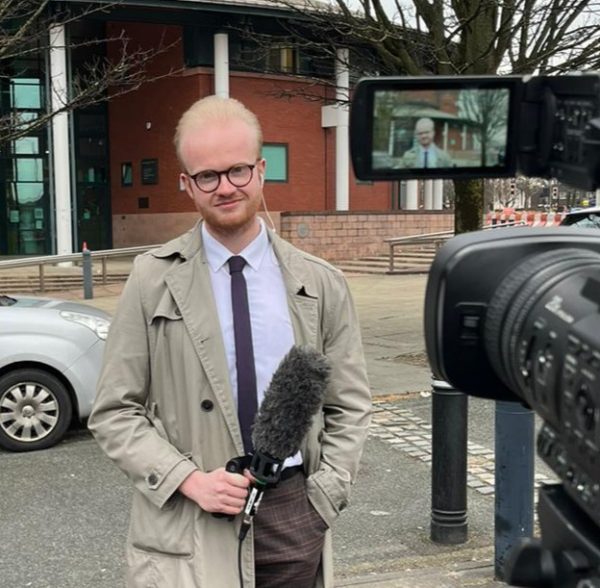
Building trust, airing concerns and showcasing local impact: how community reporters have been keeping pace with strikes
As workers from various industries in the UK’s economy have walked out over pay and conditions, community reporters have been keeping pace with developments and covering the impact on local people.
As workers from various industries in the UK’s economy have walked out over pay and conditions, community reporters have been keeping pace with developments and covering the impact on local people.
Reporters in roles covered by the Community News Project are tasked with getting to know the local community, building up contacts and addressing the real issues affecting their audiences.
To this end, community reporters have headed down to the picket lines to report on the social and economic situations in their areas, building trust in the process.

Chris Davies
For Chris Davies, community reporter for North Wales Live, his coverage of the numerous strikes, including by teachers and health workers, meant offering his readers an insightful glimpse behind the scenes of the lives of everyday workers.
Accompanying his news coverage, he opted to write a first-person piece about five things he learned while interviewing those striking.
He wanted to get the message across that, for many of the strikers, the main issue isn’t often about money, but about working conditions, staffing levels and recognition.
The 31-year-old, who is studying for the NCTJ Diploma in Journalism remotely with Darlington College, said: “I find covering strikes really interesting; it’s a real mark of our times. We haven’t had this much industrial action since Thatcher’s time.
“I was sent down to the nurses’ strike to do a Facebook Live and I got chatting to the nurses. It was really insightful for me because I was discussing issues that I wasn’t aware of, and I had done some research beforehand.
“It made me think ‘why don’t I do a piece on this?’ We always hear first from the union representatives but we never hear the voices of the people doing everyday work. I wanted to do a piece that humanises them and gives people a glimpse behind the scenes.”
Chris, who lives in Bangor, said that he had to combat the animosity that some strikers had towards the press when interviewing them.
He said: “Generally the workers who have been working for a while have been more laid back, but a lot of the younger ones are more passionate and distrustful. I’ve not had anyone be aggressive but people have looked at me with distrust.
“Rebuilding these relationships and offering those actually taking part in the action – not just union representatives – to have their say, offers a much more honest and grounded view of the challenges these workers are facing and in a time filled with so much doubt and distrust it is vital that we, as the media, do our bit to support this.”
Lucinda Herbert, a community reporter for the Blackpool Gazette, has covered strikes by teachers, train drivers and ambulance workers in recent months.
As well as heading to the picket lines, her stories have described the impact of strikes on the local community – such as how rail strikes posed a risk to tourism in Blackpool over Christmas, how health workers’ strikes could affect hospital waiting times and which schools were affected by the teachers strikes.
She said: “It has been a good opportunity for me to build trust in my community by reporting on social and economic situations that are affecting everyone in one way or another.
“It was equally important to show the negative impact the strikes had on our local economy, hospital waiting times, children missing more lessons – and the frustration felt by some of our readers.
“Blackpool has a strong hospitality industry that was hit hard by Covid, and the train strikes posed a further threat to their recovery. I wanted to present our readers with different viewpoints that also reflected the other side of the debate and present balanced coverage of strikes, while trying hard not to jeopardise the trust I had built in other sections of our community.
“I was able to provide public service journalism that kept our readers well informed with clear information about how the strikes would affect them – gathering details about local school closures, hospital announcements, etc.”

Phoebe Cox
Community reporter Phoebe Cox’s first experience of covering strikes was a couple of months into her role at the Mansfield Chad when she headed down to the picket lines at the Royal Mail head office in Mansfield.
She said: “Although I have heard a lot of stories from family and in the local community about the miners’ strikes, this was the first one I’ve been consciously aware of.
“It felt like a big responsibility and I didn’t know how I would be received, but the strikers were so welcoming and wanted to talk about the different reasons why they were striking. People have preconceived ideas about the strikes and they wanted to get across that pay isn’t the only thing.
“If I could take away one thing from talking to them, it was that they were concerned about the future of the service.”
The 25-year-old, who lives in Mansfield, said that building relationships with those striking led to her developing contacts at other strikes.
She said: “Going to the picket line in person was a big step in putting my face out there so they can see I am not just a name in an email. It was a good step to make myself known and make them feel at ease.
“They vouched for me as a good person to talk to and that spread to other strikes. I made relationships with a main union representative, as well as anonymous sources.
“It’s been quite an experience to cover the strikes. I am part of a working-class community and I got the job to bring about coverage of that area.”
Community reporters have also been live filming the strikes, airing the footage in real-time on Facebook for their audience to watch along.
Katie Oborn, community reporter for Plymouth Live, did her first Facebook Live from the Royal Mail picket line in December last year.
She said: “Although a little nervous, I thoroughly enjoyed broadcasting live via Facebook and it ended up being the most watched Facebook Live in the south west region for that week. I interviewed the union’s National Executive, Tony Bouch, at the scene along with several posties who were striking that day.”

Kimberley Hackett. Photo taken by David Gee.
Kimberley Hackett, community reporter for the Watford Observer, caught the public support given to junior doctors at the picket line when filming.
She said: “When I was there people were driving past and beeping their horns in support. I’m glad this was captured on the Facebook Live, it helped to give the viewers at home the sense of what the atmosphere was like at Watford General Hospital.
“The doctors said they were unhappy about striking, it was their last choice, but they were doing it for the long-term future of the NHS and patient safety.”

Cait Findlay
Community reporter Cait Findlay, from Cambridgeshire Live, captured her experience of covering the nursing strikes when she filmed a day in her life for the NCTJ. She was surprised to find that she was sometimes the first reporter to attend the picket line on some days.
She said: “Speaking to workers on strike in local areas is incredibly important and their stories can get lost in national coverage. These are the people who deliver our post, teach our children, work in the stations we travel through, look after us when we are unwell – many of the things we take for granted.
“They are our neighbours and our friends and the people we rely on to keep life going. I have really valued hearing from people on picket lines and marches about the struggles they are facing and have been inspired by how they stand up for themselves, even in the face of opposition. I have also seen many people honking their horns in support, or coming up to striking workers to give them words of encouragement.”
Community reporters have also had to learn to ensure their coverage is fair, accurate and balanced, making sure they fact-check opinions.
Daniel Walton, community reporter for the Express and Star, has covered both ambulance and bus strikes in the West Midlands.
He said: “I had a fantastic and enlightening time covering the strikes and following the strikers’ stories to secure a better future for themselves.
“I originally had difficulty with remaining neutral and not automatically siding with the strikers. But I found that covering this story forced me to offer those combative questions and to get into the debates.”

Tom Bedworth
Community reporter Tom Bedworth, who works for the Warrington Guardian, said: “The most important thing when covering strikes is getting across the point that you aren’t there to be for or against the strikers; you’re there to listen to what they have to say, and reflect that fairly and accurately.
“It’s useful to fact-check commonly-held beliefs, for example with the RMT strikes a lot of people were saying that train drivers get paid too much to be striking – but the train drivers aren’t even in the RMT union, they have their own one. It’s our responsibility to report the full picture, regardless of whether we personally agree or disagree with strikes.
“Once people realise that you haven’t shown up with an agenda – either critical of the strikes, or as a union mouthpiece – then they will give straight answers, and they will be receptive. A lot of the time, the conversations are incredibly constructive, and we get to ask the questions our readers want the strikers to be asked.”
The Community News Project was launched in 2019 and has to date offered opportunities to 276 individuals to become community reporters. At present, 112 community reporters are in role across the UK, with 23 different publishers. All of them are studying for NCTJ qualifications alongside their day-to-day journalism work.

